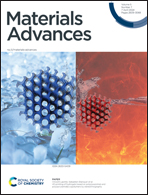Modulating mediation medium for few layered dichalcogenides enhances inhibition of common pathogens†
Abstract
As mandated by the United Nations Ad hoc Interagency Coordination Group, there is a looming prospect of acute health crises and poverty by 2030 in the absence of action against microbial resistance. Nanomaterials possess the capability to disrupt pathogenic cell membranes or induce cell death through the production of reactive oxygen species and free radicals. Hence, nanomaterials have emerged as promising agents to combat the impending crises. While research on nanomaterial-based approaches for drug-resistant infections has commenced, it is imperative to conduct parallel investigations to ascertain the maximal effectiveness of nanomaterials against common pathogens. Transition metal dichalcogenides represent the next generation of antibiotics to counter common and multidrug-resistant infections. However, existing studies predominantly focus on a limited spectrum of microorganisms or pathogens, with minimal reports on their efficacy against pathogens such as Pseudomonas aeruginosa and Candida albicans. Notably, many studies have explored the functionalization, doping, or composite formation of these nanostructures to enhance their antipathogenic activity, overlooking the intrinsic antibiotic potential of the materials in their original form. Consequently, this study investigates the antipathogenic activity of non-functionalized few-layer WS2 and MoS2 nanosheets against a range of pathogens, including Mycobacterium smegmatis, Staphylococcus aureus, Bacillus cereus, Pseudomonas aeruginosa, Yersinia pestis, Escherichia coli and Candida albicans, in lysogeny broth (LB) and potato dextrose broth (PDB) media. Remarkably, few-layer MoS2 and WS2 exhibit significant antipathogenic activity against all tested pathogens, surpassing standard antibiotics in the case of Pseudomonas aeruginosa and Candida albicans.



 Please wait while we load your content...
Please wait while we load your content...